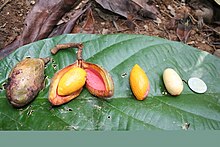Horsfieldia kingii is a dioecious tree of the family Myristicaceae. It grows up to 20 m tall[4] and has large seeds that are dispersed by frugivores such as hornbills and imperial pigeons.[5] The fruiting period is from February to May.[6] The fruit is an arillate capsule and is bi-coloured.[5]
| Horsfieldia kingii | |
|---|---|

| |
| Horsfieldia kingii fruits | |

| |
| Horsfieldia kingii leaves | |
| Scientific classification | |
| Kingdom: | Plantae |
| Clade: | Tracheophytes |
| Clade: | Angiosperms |
| Clade: | Magnoliids |
| Order: | Magnoliales |
| Family: | Myristicaceae |
| Genus: | Horsfieldia |
| Species: | H. kingii
|
| Binomial name | |
| Horsfieldia kingii (Hook. f.) Warb.[1]
| |
| Synonyms | |
The plant is referred to as ramtamul in Assamese language and is sometimes used as a substitute for betelnut. However, they could be mildly intoxicating to humans.[4] The leaves form a part of the diet of the endangered capped langur.[7]
References
edit- ^ Horsfieldia kingii at the International Plant Names Index accessible online
- ^ Hooker, JD (1886) Flora of British India 5:106
- ^ a b "The Plant List".
- ^ a b Chaudhuri, AB (1993) Forest Plants of Eastern India APH Publishing p. 434
- ^ a b Aparajita Datta & Rawat, GS (2008) Dispersal modes and spatial patterns of tree species in a tropical forest in Arunachal Pradesh, northeast India, Mongabay.com Open Access Journal - Tropical Conservation Science Vol. 1(3):163-185 PDF
- ^ Nandini Velho (2008) The effect of terrestrial rodents on seed fate of hornbill-dispersed plants in Pakke Tiger Reserve, Unpublished MSc Thesis Manipal University. pp. 81 PDF Archived 2011-07-28 at the Wayback Machine
- ^ Kumar, A & Solanki, GS (2008) Population Status and Conservation of Capped Langurs (Trachypithecus pileatus) in and around Pakke Wildlife Sanctuary, Arunachal Pradesh, India. Primate Conservation (23): 97–105 PDF Archived 2009-02-05 at the Wayback Machine